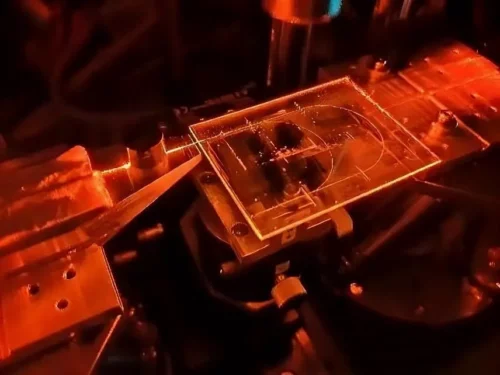Researchers at the University of Geneva have created a low-loss, high transmitting speed integrated photonics Quantum Key Distribution (QKD) system for secure key transmission.

Quantum Key Distribution (QKD), a well-established method in generating secure keys for confidential communication between distant entities, exploits the quantum properties of light to produce robust random keys. These keys are utilized for the encryption and decryption of data. In contrast to conventional communication protocols that depend on computational complexity for security, QKD’s security is based on fundamental physics principles.
Researchers at the University of Geneva have developed an integrated photonics-based QKD system, enabling the transmission of secure keys at remarkable speeds. QKD technology aims to integrate into real-world networks, requiring integrated semiconductor photonics seamlessly.
Building a faster chip-based system
The compactness, robustness, and ease of manipulation of integrated photonics improve QKD’s position as a secure communication technology, with fewer components to verify or troubleshoot. The researchers have developed a silicon photonics transmitter, combining a photonic integrated circuit and an external diode laser. Silica-based QKD receiver included a photonic integrated circuit and two-photon detectors. The team used femtosecond laser micromachining for fabrication. Transmitter utilized a laser with an integrated circuit for high-speed photon production. The receiver had an integrated circuit and external detectors for simple photon detection. Components connected with fiber for fast key production.
Low-loss, high-speed transmission
Following a comprehensive analysis of the integrated transmitter and receiver, the researchers employed them to conduct a confidential key exchange. The experiments encompass simulated fiber distances and a real-world scenario involving a 150-km long single-mode fiber, employing single-photon avalanche photodiodes that are ideal for practical applications. Additionally, investigations were conducted using single-photon superconducting nanowire detectors, resulting in an impressively low quantum bit error rate of 0.8%. Notably, the receiver exhibited polarization independence, a challenging feat in integrated photonics, and demonstrated remarkably low loss at approximately 3 dB.
The researchers stated that the new experiments yielded comparable results to previous fiber-based ones in secret key rate production and quantum bit error rates. However, the QKD system is simpler and more practical, demonstrating the feasibility of integrated circuits for this protocol. The researchers now aim to house system parts in a rack enclosure for network implementation of QKD.
Reference: “High-speed integrated QKD system” by Rebecka Sax, Alberto Boaron, Gianluca Boso, Simone Atzeni, Andrea Crespi, Fadri Grünenfelder, Davide Rusca, Aws Al-Saadi, Danilo Bronzi, Sebastian Kupijai, Hanjo Rhee, Roberto Osellame and Hugo Zbinden, 25 May 2023, Photonics Research. DOI: 10.1364/PRJ.481475







